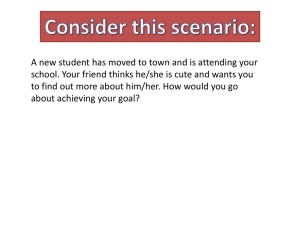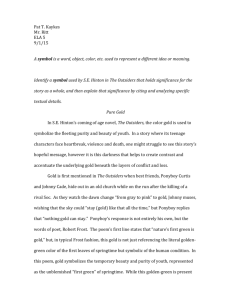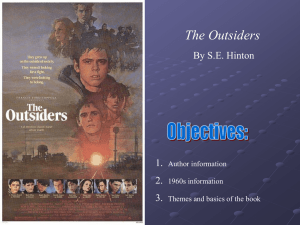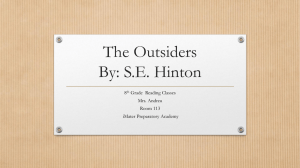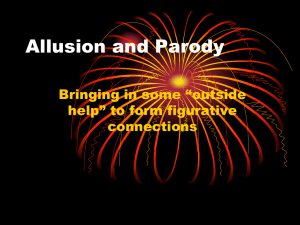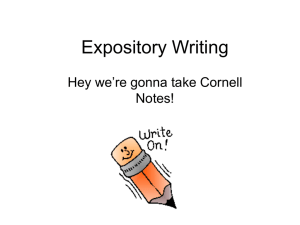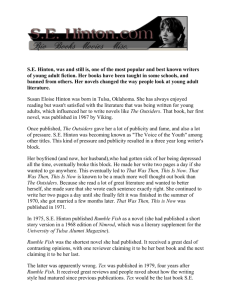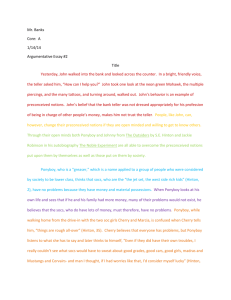lead - Sage Middle School
advertisement
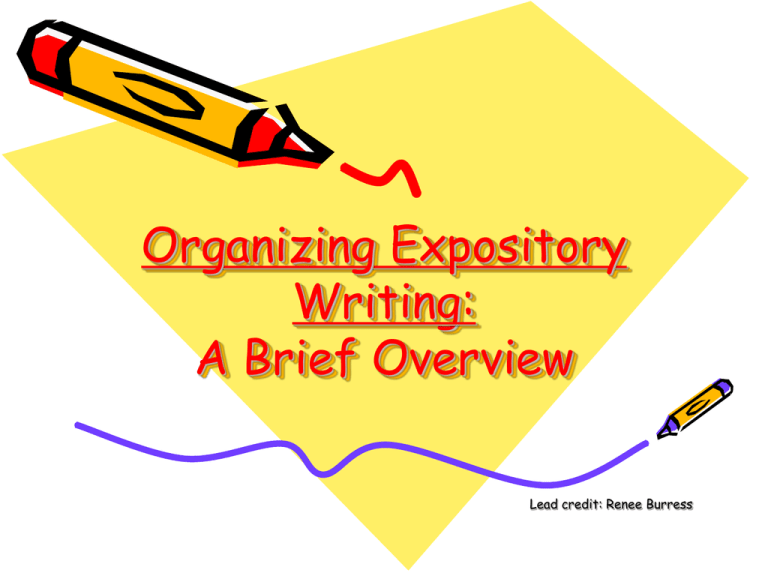
Organizing Expository Writing: A Brief Overview Lead credit: Renee Burress What a writer should create when writing an expository essay: • Interesting, controlled lead with an obvious topic sentence. • Supportive, organized body paragraphs with fluent transitions • Supportive conclusion which includes and leaves the reader with a final thought or insight To Begin: Leads A well-written lead catches the reader’s attention, making them want to read more. It also makes the writer want to write more. What is a “lead?” A lead is the beginning of any piece of writing. What is an expository lead? • An expository lead is the beginning of an informational piece of writing. What types of expository writing usually occur in school? • • • • • Compare and contrast Problem/solution Descriptive Sequential Cause and effect Different Types of Expository Leads • • • • • Snapshot Lead Observation Lead Question Lead Personal Connection Lead Set-up/Interesting Fact Lead Snapshot Lead Create a picture of the setting or event in the reader’s mind. Start with a Snapshot. When you paint a picture, you draw the reader in . Notice the difference between these two leads to a report about ice-skating. • Boring Ice-skating is my favorite sport. • Better It's ten degrees below zero and the river is frozen a foot thick. It makes snapping sounds like the limbs of trees cracking. A long figure glides along the black ice, moving toward the city. The only sound is the scraping of each blade as it bites into the river. That's me doing my favorite sport, ice-skating. Observation Lead Draw your reader in with an important observation. Start with an important observation. Don't start in the general. Put your most surprising or important observation into you opening. • General The human brain is a complex and amazing organ. • Better Seeing stars, it dreams of eternity. Hearing birds, it makes music. Smelling flowers, it is enraptured. Touching tools, it transforms the earth. But deprived of these sensory experiences, the human brain withers and dies. (Inside the Brain --- Ronald Kotulak) Question Lead Draw your reader in with a question. Start with a strongly stated question your readers might have. In some ways all writing is about trying to answer our best questions. A strong question is one we all want to know the answer to. • Weakly-stated In this paper I will attempt to answer the question why history is important. • Better What's the point of studying history? Who cares what happened long ago? After all, aren't the people in history books dead? Personal Connection Lead Start with a personal reason why you would investigate this topic . Put your connection with the subject in the lead. Why are you attracted to the subject? Do you have a personal reason for writing about this subject? What specific memories of the subject come to mind? • • General The problem of longitude was one of the greatest scientific challenges of its day. Better Once on a Wednesday excursion when I was a little girl, my father bought me a beaded wire ball that I loved. At a touch, I could collapse the toy into a flat coil between my palms, or pop it open to make a hollow sphere. Rounded out it resembled a tiny Earth, because its hinged wires traced the same pattern intersecting circles that I had seen on the globe in my school room -- the thin black lines of latitude and longitude. (Longitude --- Dava Sobel) Set-Up/ Interesting Fact Lead Set up the writing with a super-interesting hook. Flaunt your favorite bit of research in the lead. Start with the facts that made you smile, laugh, go "ahaaa" or just plain grossed you out. • General Did you ever wonder why God created flies? • Better Though we've been killing them for years now, I have never tested the folklore that with a little cream and sugar, flies taste very much like black raspberries. There are also many more types of leads: • • • • • • Riddle Definition Challenging Statement Announcement Opinion Famous or Not-so-famous quote How can you use some of these ideas in your writing? You are being asked to write a compare and contrast paper. Regardless of what lead you choose to begin your writing, you will want to write your lead well, so let’s look at some sample student leads to see what works and what doesn’t. Ponyboy Curtis, a poor boy from the east side of town, faces all kinds of problems and hard choices in S.E. Hinton’s The Outsiders. Growing up in the 60s with a mixed-up family and hoods for friends, seems like a hard character to relate to, especially in a completely different time period. But Ponyboy’s interests, feelings, and good heart immediately pulled me in. On every page was a new comparison. Amazing how a 14-year-old boy from the 60s could related so much to someone from the 21st century. R. Hunt When you picture a ‘greaser” the first thing that will pop in your head is either your mom telling you to take a shower, or the slick-backed Elvis look. The last thing you will think of would be a teenage high school girl that is frustrated with her school’s cliques. That agitated girl is S.E. Hinton; her story is The Outsiders, where I found understanding heroism, and a multiple sided story where people are people before anything else. However, most of all the different characters Ponyboy was who was most debatable being more alike, or different. • • W. Ayarza The rich and poor have always been separated from each other. Although today isn’t as bad as it was in The Outsiders. In The Outsiders the separation of the rich and poor is one of the main ideas of the book. K. Pulley As I read The Outsiders, I had a lot to think about. S.E. Hinton pushes you to think about the issues that appear in her book. As I thought about these things, I couldn’t help but realize how much alike Ponyboy, the main character, and I are. The further I got into the book, the more I saw ideas and thoughts from Ponyboy that I had thought of myself. M. Reynolds My understanding from the rich to the poor has changed from reading S.E. Hinton’s The Outsiders….. I understand S.E. Hinton’s message: don’t judge people by what they look like or how much money they have but [by] how much drive, kindness, and loyalty. S. Adams Regardless of which lead you choose for your compare and contrast paper, you will want your writing to be clear, interesting and informative while making your compare and contrast purpose obvious. Compare and Contrast Lead Example: What’s the Buzz Last summer, my grandma’s backyard overflowed with flowers and with stinging insects. At first, whenever I heard a buzz, I grabbed my flyswatter. Then Grandma showed me that not all buzzes are created equal. For example, honeybees and yellow jackets (wasps) may look similar, but they’re really very different creatures. Other important ideas to consider when writing an essay. • Organization: beg, middle, end • Transition Words: – http://www.smart-words.org/transitionwords.html – http://www.studygs.net/wrtstr6.htm Organization: • For simple organizational purposes, assume you need a beginning, middle, and end in the form of: – lead/intro paragraph – body paragraphs (min. of three) – and a concluding paragraph. Transitions: • Transitions are needed between paragraphs and are used to directly indicate to a reader a shift or change in ideas. • The keep the reading fluent and ideas connected. Transition Word/Phrases Sources: » http://www.smart-words.org/transition-words.html » http://www.studygs.net/wrtstr6.htm So, overall… When organizing an expository essay, include: • An interesting, controlled lead with an obvious topic sentence. • Supportive, organized body paragraphs with fluent transitions • A supportive conclusion which includes and leaves the reader with a final thought or insight
